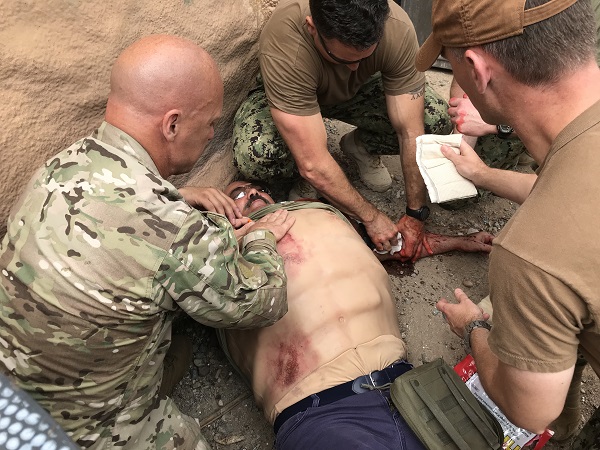MARCH 9-13, 2019 • CAESARS PALACE • LAS VEGAS, NV


Jointly provided by the Uniformed Services Chapter Division (USAAEM)
Would you like to learn about translating military damage control resuscitation strategies into your civilian practice? A unique military-civilian partnership has allowed for the widespread deployment of low titer O+ whole blood (LTO+WB) in the San Antonio metropolitan area. The Uniformed Services Chapter Division of AAEM (USAAEM) will offer our experience with deploying LTO+WB in hospitals and on ground ambulances. We will also provide education on a variety of techniques (REBOA, modified thoracotomy, and AAJT) you can deploy in the setting of traumatic arrest and peri-arrest. Approximately 25% of the time will be dedicated to hand-on instruction and demonstrations.
← Back to all pre-conference courses

Previous USAAEM pre-conference course.
Register Today!
Add this course when you register for AAEM19.
There are no prerequisites for the course.
This activity has been planned and implemented in accordance with the Essential Areas and policies of the Accreditation Council for Continuing Medical Education (ACCME) through the joint providership of the American Academy of Emergency Medicine (AAEM) and the Uniformed Services Chapter Division of the American Academy of Emergency Medicine (USAAEM). The American Academy of Emergency Medicine (AAEM) is accredited by the ACCME to provide continuing medical education for physicians.
The American Academy of Emergency Medicine designates this live activity for a maximum of 4.75 AMA PRA Category 1 Credits™. Physicians should claim only the credit commensurate with the extent of their participation in the activity.
*The registration fee will be refunded within 30 days after Scientific Assembly for USAAEM members who attend Bleeding to Death? What’s New in Military Hemorrhage Control course
Saturday, March 9, 2019
|
12:30pm-1:00pm |
Introduction |
|
1:00pm-1:25pm |
Whole Blood Resuscitation: Current Military Practice and Literature Review |
|
1:30pm-1:55pm |
Deploying LTO+WB in a Civilian EMS System: The SAFD Experience |
|
2:00pm-2:25pm |
LTO+WB into your ED: The SAMMC Experience |
|
2:30pm-2:55pm |
Hands-on: Transfusing Fresh Whole Blood |
|
3:00pm-3:25pm |
Single Provider REBOA: London HEMS Experience |
|
3:30pm-3:55pm |
A Better Thoracotomy: London HEMS Experience |
|
4:00pm-4:25pm |
AAJT: The Poor Man's REBOA? |
|
4:30pm-5:45pm |
Hands-On: AAJT and REBOA Trainers |
Julian Mapp, MD MBA MPH FAAEM
Assistant Professor, Department of Military and Emergency Medicine, USUHS
Zachary Sletten, MD
CPT, MC, US Army, Staff Physician and Simulation Director, Brooke Army Medical Center, San Antonio TX
CJ Winckler, MD
Deputy Medical Director, San Antonio Fire Department EMS, San Antonio, TX
John G. Knight Jr., MD
Director Operational Medicine, EM Residency and EDUS Fellowship Faculty, San Antonio, TX
Ryan Newberry, DO MPH
Physician Researcher, US Army Institute of Surgical Research, San Antonio, TX
Kevin Foss, MD
Emergency Medicine Chief Resident Madigan Army Medical Center